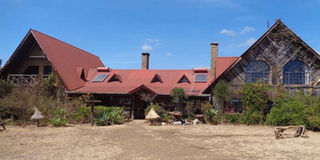RUPI MANGAT: Sounds of Sandai

The main house at Sandai in Mweiga. PHOTO| RUPI MANGAT
What you need to know:
It’s been a spiritual weekend away from the clutter of life. Walking around Sandai, a beautiful home-stay built with so much grace and beauty, a leopard has left the coarse remains of his last night’s meal by the dry river while elephants passed though on their
way from the Aberdares to My Kenya.
Everyone’s looking to the skies for rain to end the long drought. On one side of the house that’s called Sandai, the long range of the Aberdares is hidden in the clouds, as is Mt Kenya on the other side.
Yet anytime now El Nino is expected and then the dry earth we walk on will burst into colours of wild flowers, pools and streams overflowing with water.
In the eventide as the sun slinks behind the Aberdares and in the quietness of the forest, everyone is silent walking through the forest; it is meditation in nature. The reverberating metallic sound of the singing bowl lingers while birds chirp, zebra grunt and horses bray.
Petra Allmendinger of Sandai reaches for a clover in a pool of water along a seasonal riverbed that shows its boulders and stones and fat roots of trees that are otherwise submerged in water. I’m staring at a four-leaf clover and exclaim silently. Three-leaved clovers are common but myth has it that finding a four-leaf clover signals good tidings. The seasonal pool is full of them.
Every few paces, we linger by a tree or rock to admire the beauty. Finally, on reaching a flat rock surface, a huge tamtam (gong) cuts a dramatic effect with Petra Klug, the sound therapist, seated cross-legged in front of it.
Klug is the only known practitioner of sound therapy in Africa. Invited to sit on the rock around her, she begins to strike the tamtam – at first gently and then harder, the sounds reverberating louder and louder to fill the mind and body. Gradually, she brings the sounds to a standstill. “Sound meditation centres you,” explains Klug. “It brings you into your unconscious stage, called the alpha stage.”
In the alpha state, the brain goes into a stage of higher consciousness, releasing blockages in the body. In this relaxed state, the self-healing system is activated. “I never promise cure but only help to get you better,” says the lithe woman.
Sound has been used for thousands of years in Eastern healing – and it’s perchance that Klug first came upon a metallic bowl in a local market while living in New Delhi, India. When she asked the vendor what it was, he replied “It’s a singing bowl.”
“I asked him why it was called a singing bowl. He struck it with a stick. In a market full of people and noise, the only sound that I became aware of was the sound of the bowl. I was mesmerised.
“The man said – buy the bowl and it will change your life. And it did. I started collecting these bowls and when I returned to Germany I found an institute where they were teaching sound therapy.”
The next morning, session begins with the sound meditation at the same place with the sun rising over the shoulder of Mount Kenya. After a healthy breakfast on the verandah, we’re in for a bowl massage.
Lying on the floor, Klug places the singing bowls on parts of the body and strikes them gently every few minutes keeping the vibrating sound going. According to sound therapist, humans are made up of different energy frequencies which can be attuned to rebalance the body’s energy.
“We start the sound in supporting what is already good in the body.” The brain then follows the sound – from the dark to the light sound – to lead the pain away from the problem. And you need more than one session.
It’s been a spiritual weekend away from the clutter of life. Walking around Sandai, a beautiful home-stay built with so much grace and beauty, a leopard has left the coarse remains of his last night’s meal by the dry river while elephants passed though on their
way from the Aberdares to My Kenya. In an ever shrinking world for the last of the wild, wildlife corridors like these are crucial for migrations to continue, giving time for the land to revive before the pachyderms return.
For more information on Sandai House please visit www.africanfootprints.de




